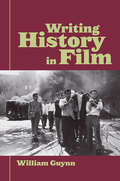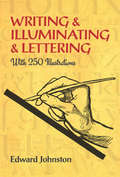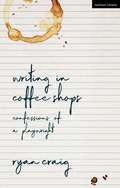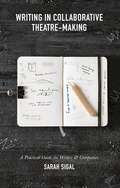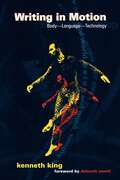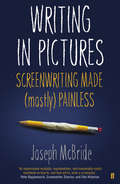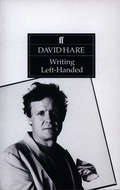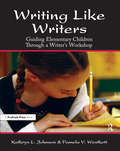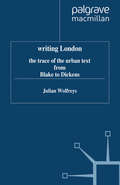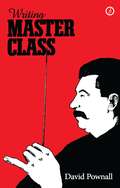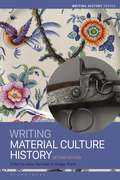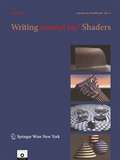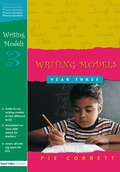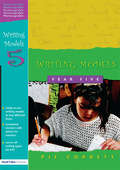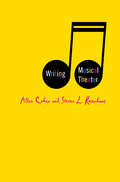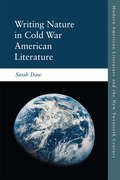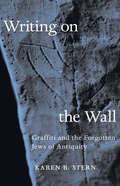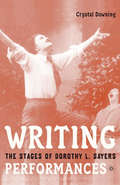- Table View
- List View
Writing History in Film
by William GuynnHistorical film has been an important genre since the earliest silent films. The French Revolution, the American Civil War, the conquest of the New World, World War II--all have been repeatedly represented in film. But how do we distinguish between fictionalized spectacle and authentic historical representation? Writing History in Film sets out the narratological, semiological, rhetorical, and philosophical bases for understanding how film can function as a form of historical interpretation and representation. With case studies and an interdisciplinary approach, William Guynn examines the key issues facing film students and scholars, historians, and anyone interested in how we see our historical past.
Writing & Illuminating & Lettering: With 250 Illustrations
by Edward JohnstonOne of the founders of modern calligraphy, Edward Johnston regarded lettering, writing, and illuminating as not only desirable ends in themselves but also as practical avenues to mastery of typography, decoration, and design. In this classic, profusely illustrated guide, he distilled his expertise into a series of easy-to-follow lessons that will benefit any student of calligraphy, book design, or art.Part I is devoted to writing and illuminating. Early chapters cover the fundamentals of acquiring a formal hand: choosing paper, ink, and quills; holding the pen; spacing and planning a manuscript; and more. The author then turns to the techniques of producing a manuscript book: tools and materials, methods and proportions, margins, and other methods. Part II offers a detailed discussion of lettering: the qualities of good lettering, methods of construction and arrangement, spacing, proportion, and other matters. Two appendixes cover the uses of lettering in book bindings, wall inscriptions, monograms, and title pages as well as the techniques involved in lettering on metal, wood, and stone.
Writing in Coffee Shops: Confessions of a Playwright
by Ryan CraigWhat makes someone a playwright?How do their identities and ideas interweave and co-exist?What permanent truths can we discern from examining existing texts?How can we write theatre that encapsulates the contemporary moment?How do we develop an idea from the embryonic impulse to a full and robust piece of theatre? In this fresh, lively and often very funny book, playwright Ryan Craig makes a case for the vitality of playwriting in our contemporary world and offers a way into writing those plays.From the very first moment of the process, as you sit in a coffee shop, staring at your 'laptop yawning open like some big, gormless mouth, the screen a flickering blank', to seeing your play staged and reviewed, the author takes you through the complete journey. Drawing on his own experience of writing for theatres such as the National, Hampstead and Tricycle and Menier Chocolate Factory, TV drama scripts for BBC, ITV and Channel Four, radio plays and adaptation, as well as commercial theatre, the author explores what practical tools the dramatist can use to write plays that build bridges between us. Full of practical advice for the aspiring - and practising - playwright, this book is also an important call-to-arms for playwrights everywhere, arguing for its necessity in the context of an increasingly fractured, distracted, disconnected world.
Writing in Coffee Shops: Confessions of a Playwright
by Ryan CraigWhat makes someone a playwright?How do their identities and ideas interweave and co-exist?What permanent truths can we discern from examining existing texts?How can we write theatre that encapsulates the contemporary moment?How do we develop an idea from the embryonic impulse to a full and robust piece of theatre? In this fresh, lively and often very funny book, playwright Ryan Craig makes a case for the vitality of playwriting in our contemporary world and offers a way into writing those plays.From the very first moment of the process, as you sit in a coffee shop, staring at your 'laptop yawning open like some big, gormless mouth, the screen a flickering blank', to seeing your play staged and reviewed, the author takes you through the complete journey. Drawing on his own experience of writing for theatres such as the National, Hampstead and Tricycle and Menier Chocolate Factory, TV drama scripts for BBC, ITV and Channel Four, radio plays and adaptation, as well as commercial theatre, the author explores what practical tools the dramatist can use to write plays that build bridges between us. Full of practical advice for the aspiring - and practising - playwright, this book is also an important call-to-arms for playwrights everywhere, arguing for its necessity in the context of an increasingly fractured, distracted, disconnected world.
Writing in Collaborative Theatre-Making (PDF)
by Sarah SigalThis engaging text explores the role of the writer and the text in collaborative practice through the work of contemporary writers and companies working in Britain, offering students and aspiring writers and directors effective practical strategies for collaborative work.
Writing in Motion: Body—Language—Technology
by Kenneth KingKenneth King is one of America's most inventive postmodern choreographers. His dancing has always reflected his interest in language and technology, combining movement with film, machines, lighting and words both spoken and written. King is also conversant in philosophy, and some of his most influential dances have been dedicated to and in dialogue with the work of such philosophers as Susanne K. Langer, Edmund Husserl and Friedrich Nietzsche. Since the 1960s, he has performed his dance to texts both spoken and prerecorded—texts intended to stand separately as literary works.Writing in Motion spans more than thirty years and is collected here for the first time. It includes essays, performance scripts of King's own work, art criticism, philosophy and cultural commentary. Dense with movement, these writings explode and reconfigure the familiar, crack syntax open, and invent startling new words. Dancing, to King, is "writing in space," and writing is a dance of ideas. Whether referencing Aristotle, Langer, Simone de Beauvoir, MTV, Maurice Blanchot or Marshall McLuhan, King's delightfully lavish prose is very much "in motion."
Writing in Pictures: Screenwriting Made (Mostly) Painless
by Joseph McBrideUnlike most how-to books on screenwriting, Writing in Pictures is highly practical, offering a realistic guide to the screenwriting profession, as well as concrete practical guidance in the steps professional writers take to write a screenplay that comes from the heart instead of the pocketbook. The readeris taken through the nitty-gritty process of conceiving, outlining, constructing, and writing a screenplay in the professional format, with clear and concise examples offered for every step in writing a short dramatic film.Writing in Pictures offers straight talk, no mumbo-jumbo or gimmicks, just a methodical, step-by-step process that walks the reader through the different stages of writing a screenplay -- from idea to outline to character biography to treatment to step outline to finished screenplay. Using well-known films and screenplays, both contemporary and classic, to illustrate its lessons, Writing in Pictures also offers comments from famous screenwriters past and present and insightful stories (often colorful and funny) that illuminate aspects of the craft.
Writing Left-Handed: Collected Essays
by David HareThe leading British writer-director of his generation, David Hare is also one of the most productive. The last two years have seen the outstanding success of two stage plays, The Secret Rapture and Racing Demon, and the release of two films, Paris by Night and Strapless.The pieces collected here, written left-handed, form both a concealed professional autobiography and a lucid commentary on his work.
Writing Like Writers: Guiding Elementary Children Through a Writer's Workshop
by Pamela V. Westkott Kathryn L. JohnsonBuild a classroom of excited, talented young writers. This wonderful teaching resource offers a complete approach to creating a classroom of enthusiastic, skillful student writers.The authors provide a comprehensive approach to teaching writing in the classroom. This book offers the strategies teachers need to teach writing skills that meet national standards and to produce excellent results from children.Topics addressed in this guidebook include:creating the writing classroom,teaching the writing process,teaching effective writing strategies,teaching elements of story structure,teaching the advanced craft of writing, andusing a writer's workshop to teach good writing. Writing is a great differentiator. During the writer's workshop, each student is engaged in meaningful ways. Pulling together more than three decades of practical experience and research on the best strategies for teaching writing, Writing Like Writers offers a friendly, easy-to-use guide for any teacher seeking to build a classroom of successful writers.Grades 2-6
Writing Like Writers: Guiding Elementary Children Through a Writer's Workshop
by Pamela V. Westkott Kathryn L. JohnsonBuild a classroom of excited, talented young writers. This wonderful teaching resource offers a complete approach to creating a classroom of enthusiastic, skillful student writers.The authors provide a comprehensive approach to teaching writing in the classroom. This book offers the strategies teachers need to teach writing skills that meet national standards and to produce excellent results from children.Topics addressed in this guidebook include:creating the writing classroom,teaching the writing process,teaching effective writing strategies,teaching elements of story structure,teaching the advanced craft of writing, andusing a writer's workshop to teach good writing. Writing is a great differentiator. During the writer's workshop, each student is engaged in meaningful ways. Pulling together more than three decades of practical experience and research on the best strategies for teaching writing, Writing Like Writers offers a friendly, easy-to-use guide for any teacher seeking to build a classroom of successful writers.Grades 2-6
Writing London: The Trace of the Urban Text from Blake to Dickens
by J. WolfreysWriting London asks the reader to consider how writers sought to respond to the nature of London. Drawing on literary and architectural theory and psychoanalysis, Julian Wolfreys looks at a variety of nineteenth-century writings to consider various literary modes of productions as responses to the city. Beginning with an introductory survey of the variety of literary representations and responses to the city, Writing London follows the shaping of the urban consciousness from Blake to Dickens, through Shelley, Barbauld, Byron, De Quincey, Engels and Wordsworth. It concludes with an Afterword which, in developing insights into the relationship between writing and the city, questions the heritage industry's reinvention of London, while arguing for a new understanding of the urban spirit.
Writing 'Master Class'
by David PownallWriting Master Class is the biography of David Pownall’s play, Master Class (1983), from conception to coming of age. Threaded through the account of the inception and development of the piece are twists of authorial life-story necessary for the telling. Whereas a novel or poem can be kept a secret until it is properly finished, a play has to go out to meet the people early. On the day the script is put into the hands of actors, the soul of the thing passes out of the author’s control. It can be bent, battered, warped – or improved within its being far beyond expectations. As a drama of dictatorship in art and the cleverness needed to evade its worst manifestations, Master Class has been at large for thirty years, produced in twenty countries, in some several times. What has been done to it, how it has fared, is touched upon but the main story in this book is the making of the piece. This is a fascinating insight into the playwright’s craft.
Writing Material Culture History (Writing History)
by Edited byAnne Gerritsen and Giorgio RielloWriting Material Culture History examines the methodologies currently used in the historical study of material culture. Touching on archaeology, anthropology, art history and literary studies, the book provides history students with a fundamental understanding of the relationship between artefacts and historical narratives. The role of museums, the impact of the digital age and the representations of objects in public history are just some of the issues addressed in a book that brings together distinguished scholars from around the world.This new edition includes:* A new wide-ranging introduction highlighting the role of material culture in the modern period and presenting recent contributions to the field.* A more balanced and easy-to-use structure, including 9 methodological chapters and 20 'object in focus' chapters consisting of case studies for classroom discussion.* 5 fresh 'object in focus' chapters showing greater engagement with 20th-century material culture, non-European artefacts (particularly in relation to issues of power, indigenity and repatriation of objects), architecture (with pieces on industrial heritage in Europe and on heritage destruction in China) and the definitions and limits of material culture as a discipline.* Expanded online resources to help students navigate the museums/institutions holding key artefacts.* Historiographical updates and revisions throughout the text.Focusing on the global dimension of material culture and bridging the gap between the early modern and modern periods, Writing Material Culture History is an essential tool for helping students understand the potential of objects to re-cast established historical narratives in new and exciting ways.
Writing Material Culture History (Writing History)
Writing Material Culture History examines the methodologies currently used in the historical study of material culture. Touching on archaeology, anthropology, art history and literary studies, the book provides history students with a fundamental understanding of the relationship between artefacts and historical narratives. The role of museums, the impact of the digital age and the representations of objects in public history are just some of the issues addressed in a book that brings together distinguished scholars from around the world.This new edition includes:* A new wide-ranging introduction highlighting the role of material culture in the modern period and presenting recent contributions to the field.* A more balanced and easy-to-use structure, including 9 methodological chapters and 20 'object in focus' chapters consisting of case studies for classroom discussion.* 5 fresh 'object in focus' chapters showing greater engagement with 20th-century material culture, non-European artefacts (particularly in relation to issues of power, indigenity and repatriation of objects), architecture (with pieces on industrial heritage in Europe and on heritage destruction in China) and the definitions and limits of material culture as a discipline.* Expanded online resources to help students navigate the museums/institutions holding key artefacts.* Historiographical updates and revisions throughout the text.Focusing on the global dimension of material culture and bridging the gap between the early modern and modern periods, Writing Material Culture History is an essential tool for helping students understand the potential of objects to re-cast established historical narratives in new and exciting ways.
Writing mental ray® Shaders: A Perceptual Introduction (mental ray® Handbooks #3)
by Andy KopraAn increasing number of artists and programmers in visual effects and broadcast production now use mental ray, a high performance rendering engine for generating photorealistic images. This book details the aesthetics of rendering with mental ray. It describes the varieties of shader programming from the point of view of increasing perceptual complexity: from color to the output of the final image. It includes many example shaders, including the simplest shader possible in each category that can serve as a starting point for further customization.
Writing Models Year 3 (Writing Models Ser.)
by Pie CorbettTeachers who want to cut lesson planning time should welcome this series, revised in line with the new literacy framework in the second edition. Writing Models aims to help teachers cover every sort of writing type they need; fine tune lessons by following key teaching points for each model; and deliver the new literacy units to pupils of varying a
Writing Models Year 3
by Pie CorbettTeachers who want to cut lesson planning time should welcome this series, revised in line with the new literacy framework in the second edition. Writing Models aims to help teachers cover every sort of writing type they need; fine tune lessons by following key teaching points for each model; and deliver the new literacy units to pupils of varying a
Writing Models Year 5
by Pie CorbettTeachers who want to cut planning time and save energy should welcome this series. It will help teachers to: cover every sort of writing type they need to at Key Stage with a model provided for each one; fine tune lessons by following key teaching points for each model; deliver the literacy hour to pupils of every ability using different versions of the same model.
Writing Models Year 5 (Writing Models Ser.)
by Pie CorbettTeachers who want to cut planning time and save energy should welcome this series. It will help teachers to: cover every sort of writing type they need to at Key Stage with a model provided for each one; fine tune lessons by following key teaching points for each model; deliver the literacy hour to pupils of every ability using different versions of the same model.
Writing Musical Theater
by A. Cohen S. RosenhausThis guide to the modern musical covers the entire process of creating a show, from finding and working out the initial idea, through to the ways in which writers can market a finished show and get it produced. For the interested theatregoer and writers, it is written in a lively and user-friendly style and illustrated with numerous examples.
Writing Nature in Cold War American Literature
by Sarah DawA study of a key modernist form, its theory, practice and legacy.
Writing Nature in Cold War American Literature (Modern American Literature The New Twentieth Century Ser.)
by Sarah DawExplores the neglected subject of Gothic B-movies in the Americas, Europe, Asia and Africa
Writing on the Wall: Graffiti and the Forgotten Jews of Antiquity
by Karen SternFew direct clues exist to the everyday lives and beliefs of ordinary Jews in antiquity. Prevailing perspectives on ancient Jewish life have been shaped largely by the voices of intellectual and social elites, preserved in the writings of Philo and Josephus and the rabbinic texts of the Mishnah and Talmud. Commissioned art, architecture, and formal inscriptions displayed on tombs and synagogues equally reflect the sensibilities of their influential patrons. The perspectives and sentiments of nonelite Jews, by contrast, have mostly disappeared from the historical record. Focusing on these forgotten Jews of antiquity, Writing on the Wall takes an unprecedented look at the vernacular inscriptions and drawings they left behind and sheds new light on the richness of their quotidian lives.Just like their neighbors throughout the eastern and southern Mediterranean, Mesopotamia, Arabia, and Egypt, ancient Jews scribbled and drew graffiti everyplace--in and around markets, hippodromes, theaters, pagan temples, open cliffs, sanctuaries, and even inside burial caves and synagogues. Karen Stern reveals what these markings tell us about the men and women who made them, people whose lives, beliefs, and behaviors eluded commemoration in grand literary and architectural works. Making compelling analogies with modern graffiti practices, she documents the overlooked connections between Jews and their neighbors, showing how popular Jewish practices of prayer, mortuary commemoration, commerce, and civic engagement regularly crossed ethnic and religious boundaries.Illustrated throughout with examples of ancient graffiti, Writing on the Wall provides a tantalizingly intimate glimpse into the cultural worlds of forgotten populations living at the crossroads of Judaism, Christianity, paganism, and earliest Islam.
Writing on the Wall: Graffiti and the Forgotten Jews of Antiquity
by Karen SternFew direct clues exist to the everyday lives and beliefs of ordinary Jews in antiquity. Prevailing perspectives on ancient Jewish life have been shaped largely by the voices of intellectual and social elites, preserved in the writings of Philo and Josephus and the rabbinic texts of the Mishnah and Talmud. Commissioned art, architecture, and formal inscriptions displayed on tombs and synagogues equally reflect the sensibilities of their influential patrons. The perspectives and sentiments of nonelite Jews, by contrast, have mostly disappeared from the historical record. Focusing on these forgotten Jews of antiquity, Writing on the Wall takes an unprecedented look at the vernacular inscriptions and drawings they left behind and sheds new light on the richness of their quotidian lives.Just like their neighbors throughout the eastern and southern Mediterranean, Mesopotamia, Arabia, and Egypt, ancient Jews scribbled and drew graffiti everyplace--in and around markets, hippodromes, theaters, pagan temples, open cliffs, sanctuaries, and even inside burial caves and synagogues. Karen Stern reveals what these markings tell us about the men and women who made them, people whose lives, beliefs, and behaviors eluded commemoration in grand literary and architectural works. Making compelling analogies with modern graffiti practices, she documents the overlooked connections between Jews and their neighbors, showing how popular Jewish practices of prayer, mortuary commemoration, commerce, and civic engagement regularly crossed ethnic and religious boundaries.Illustrated throughout with examples of ancient graffiti, Writing on the Wall provides a tantalizingly intimate glimpse into the cultural worlds of forgotten populations living at the crossroads of Judaism, Christianity, paganism, and earliest Islam.
Writing Performances: The Stages of Dorothy L. Sayers
by C. DowningAfter Dorothy L. Sayers became famous for her fictional sleuth, Lord Peter Wimsey, she began investigating the mysteries of Anglo-Catholic Christianity, writing plays for both stage and radio. However, because her modernist contemporaries disdained both best-sellers and religious fiction, Sayers has been largely overlooked by the academy. Writing Performances is the first work to position Sayers' diverse writings within the critical climate of high modernism. Employing exuberant illustrations from Sayers' detective fiction to make theoretical issues accessible, the book employs insights from performance theory to argue that Sayers, though a popularizer, presciently anticipated the postmodern ironizing of Enlightenment rationality and scientific objectivity.
